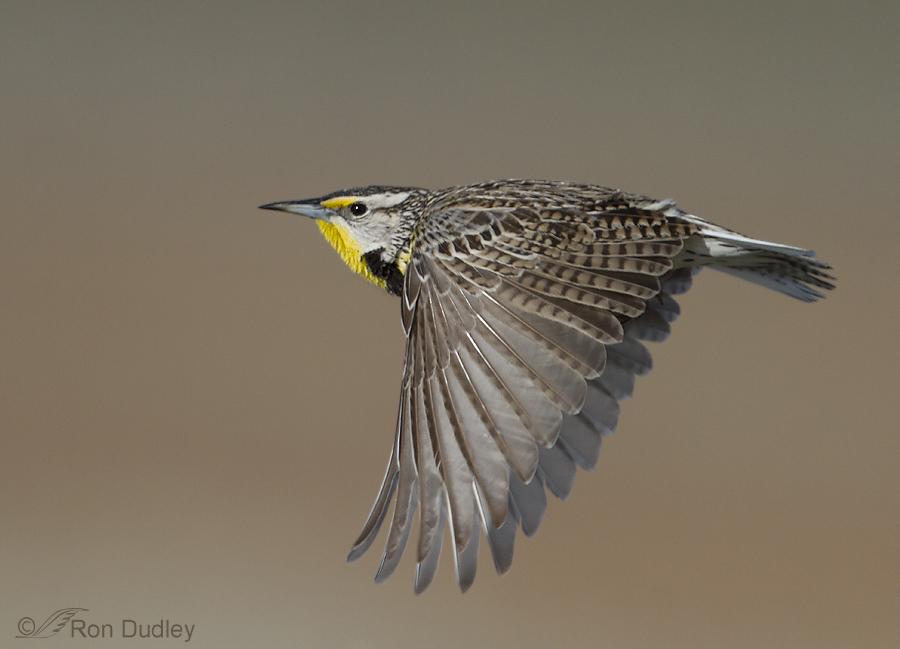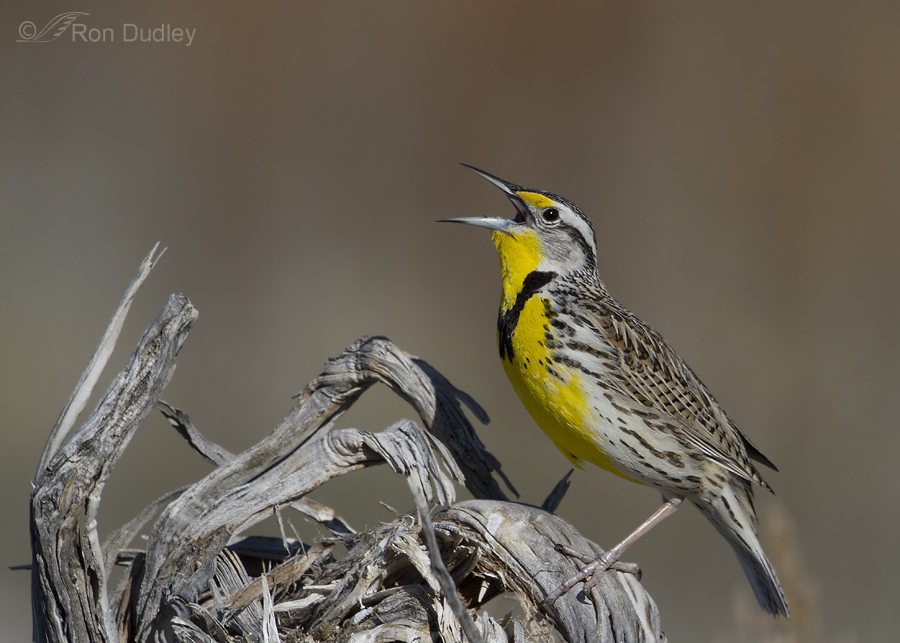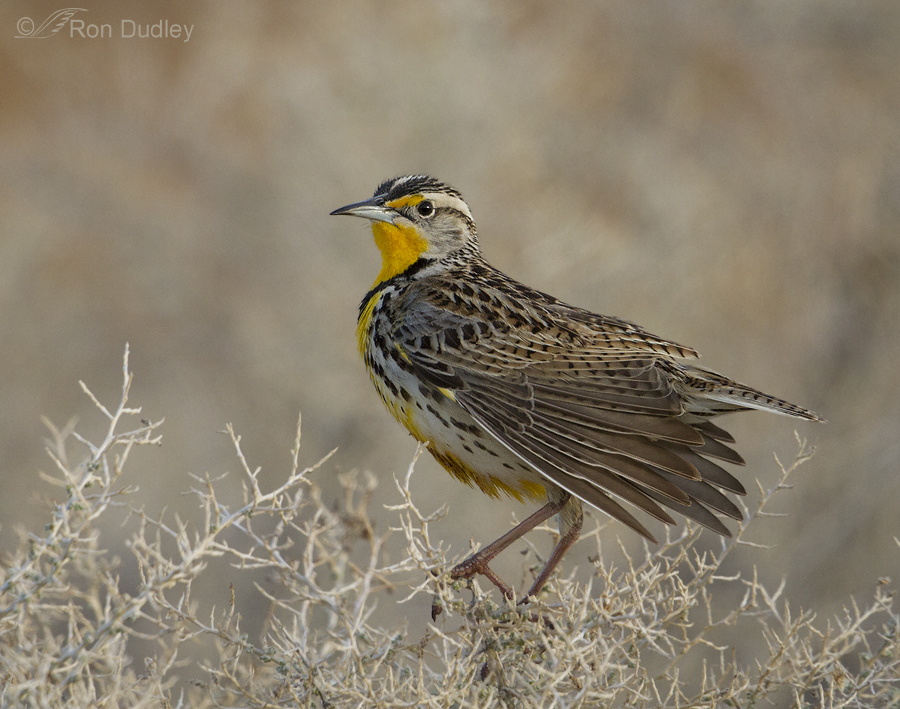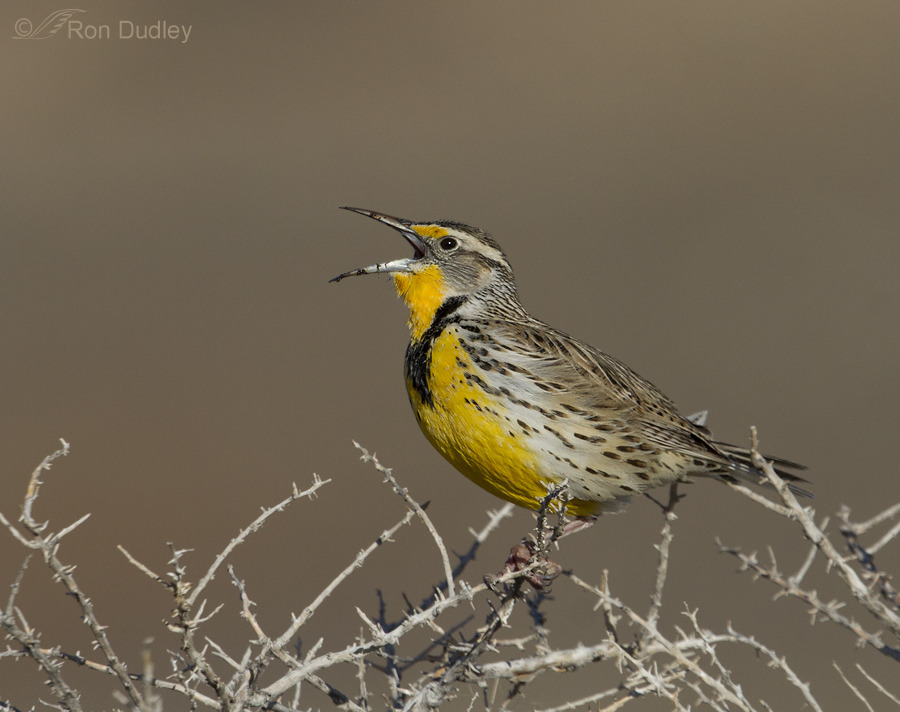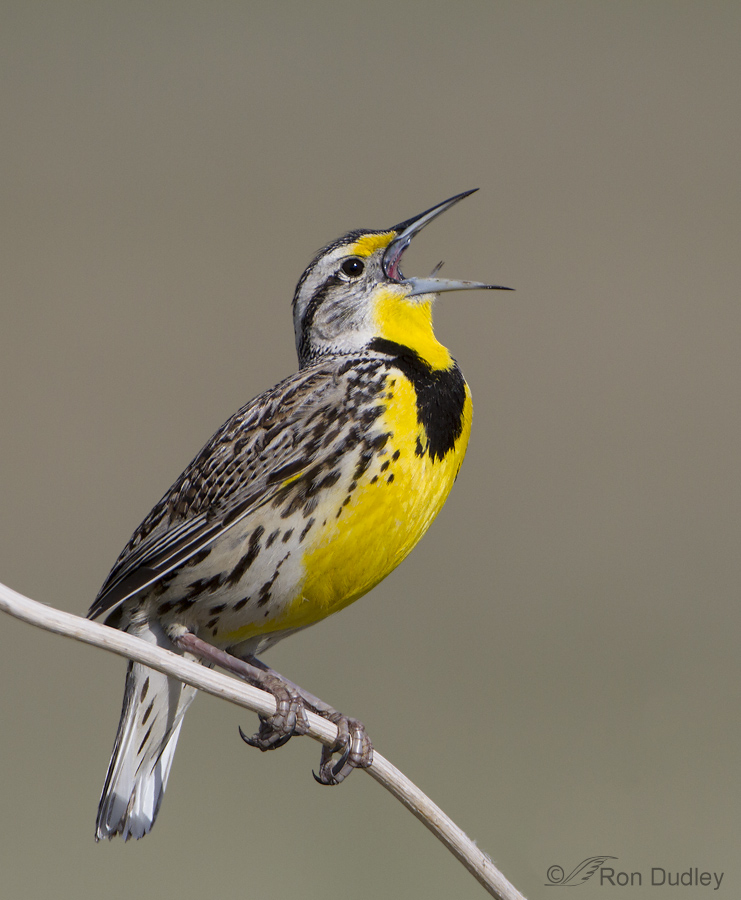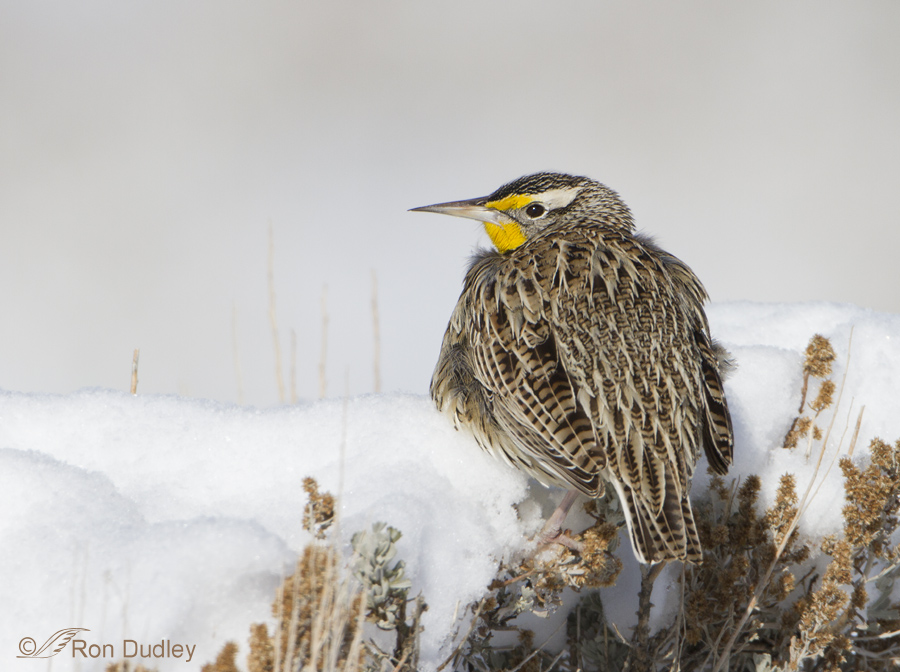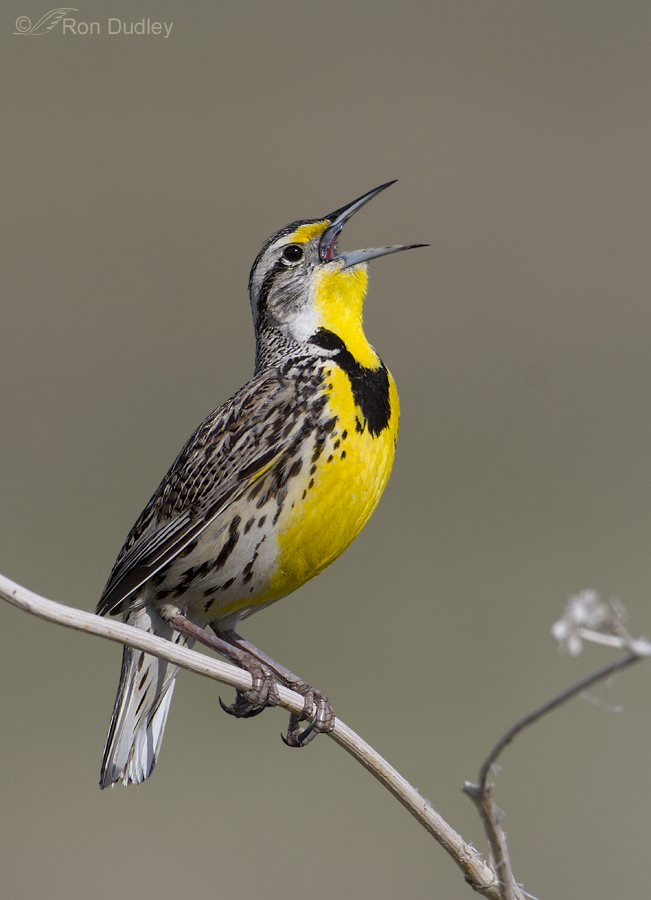Tag: sturnella neglecta
Meadowlark Singing On Sagebrush
Goofy Western Meadowlark
Western Meadowlarks Of Spring
Western Meadowlark – The Scars Of Battle
Western Meadowlark In The Snow
Comparing Adult and Juvenile Meadowlarks – Plus A Bit Of A Laugh
A Minor Meadowlark Surprise
Yesterday morning I found this Western Meadowlark perched up high, in pretty good light and with a clean background so I couldn’t resist firing away.
Antelope Island – A Meadowlark Mecca
Antelope Island is still teeming with Western Meadowlarks and will be for the rest of the summer. Most are uncooperative but there are exceptions.
Meadowlark – Wary At First, Then Singing With Gusto
I tend to like gnarly old sagebrush perches and I’ve had my eye on this one for a while. It’s close to the road, in good light in the morning and Western Meadowlarks use it often. But unlike when they’re perched on an ugly sign, they always seem to fly off as I approach when they’re on this one.
That changed yesterday morning.
A Couple Of More Meadowlarks
I wanted to post two more recent Western Meadowlark images that weren’t take-off shots, like my last post of this species. 1/2500, f/6.3, ISO 500, 500 f/4, 1.4 tc, natural light This image, taken four days ago, shows the bright yellows on the belly, breast and throat but part of the bird is obscured. Obviously it was singing up a storm. Just looking at the image brings the song into my head. 1/5000, f/5.6, ISO 640, 500 f/4, 1.4 tc, natural light And this one, from two days ago, shows the backside. I was very close to this bird. So close that I had to shoot vertically, which complicates things with my long, awkward lens. By the time I had it framed and got off a few shots I realized that my settings were wrong for the situation (didn’t need the high ISO or shutter speed and more depth of field would have kept more of the sagebrush sharp) but by then it was too late and the bird took off. Sometimes birds cooperate and then they don’t… Ron PS – As I was working on this post which was meant to be published tomorrow morning I hit “publish” instead of “update” before it was ready. So there’s some “hiccups” in it, especially for those who get the post emails. Sorry. I’ve always worried about doing that…
A Meadowlark Morning
Yesterday morning there was meadowlark magic on the island. They were almost everywhere, singing lustily from atop their sagebrush and rabbitbrush perches (and more than a few ugly signposts). Several times I just stopped the truck, turned the engine off and got outside to listen. You could hear dozens of them simultaneously – some very close, some far away and others everywhere in between. Their melodious calls literally bounced off the hilltops.
My First Western Meadowlark Of The Season
Ok, despite the fact that it’s turning colder again this week I’m now convinced that spring has arrived because two days ago I finally got close enough to photograph a singing Western Meadowlark – my first of the year. 1/2500, f/6.3, ISO 640, 500 f/4, 1.4 tc, natural light I was sure the bird would fly off as I approached, just as all the others have this spring, but this one stuck. I like the somewhat different head angle in this shot. 1/2000, f/6.3, ISO 500, 500 f/4, 1.4 tc, natural light I probably have more trouble with framing this species than any other because their legs are always longer than I think they are when they’re buried in the perch like this and I typically don’t leave enough room for at least one of them. This time I think I did. 1/3200, f/6.3, ISO 640, 500 f/4, 1.4 tc, natural light When the bird would break out in song it truly lifted my spirits, as it always does. They’re just so enthusiastic about it and when you’re close the sound can go right through you – in a good way. I’m always impressed by the size of their mouth which seems to be exaggerated some by that long beak. I suspect there are a few of my regular readers who are unfamiliar with the call of this songster (Elephant’s Child in Australia, for example) so I’ve provided a link to their song if you’d like to hear it (scroll down about half-way). These birds (and their…
Too Cold For Meadowlarks?
I’m used to seeing Western Meadowlarks all winter long. True, their numbers go down as some of them migrate south but there always seems to be a resident population of them here in northern Utah and I typically photograph them year-round. Not so this winter. 1/3200, f/7.1, ISO 500 500 f/4, 1.4 tc, natural light (techs were set for take-off) This is the last meadowlark I photographed, taken on 28 December, 2012 and it’s been weeks since I’ve even seen one. Though they’re a permanent resident in my area we’re right on the border between their “permanent resident” and “breeding resident” ranges – see map if you’re interested. I suspect they’ve all vamoosed for warmer climes because of our recent extremes of cold and snow. If that’s the case, this is one more species I’ll add to my list of birds whose return I’ll anticipate as harbingers of spring. Ron
Western Meadowlarks In Snow
Yesterday was a glorious day on the island with about 6″ of fresh snow and wonderful light. It was simply delightful. The Western Meadowlarks seemed to be a little “stickier” than usual, perhaps because of all the snow. 1/3200, f/6.3, ISO 500, 500 f/4, 1.4 tc, natural light This one was half buried in the snow but I liked all the convolutions in the snowy setting. 1/3200, f/8, ISO 500, 500 f/4, 1.4 tc, natural light This meadowlark was the most cooperative bird of the morning as it posed for me for over 6 minutes on top of some rabbitbrush. 1/2500, f/8, ISO 500, 500 f/4, 1.4 tc, natural light It never did turn around to show that bright yellow breast but it did give me some nice head turns to make up for it. 1/2000, f/7.1, ISO 500, 500 f/4, 1.4 tc, natural light Meadowlarks are well-known for a behavior called “tail flashing”, something they often do during territorial disputes. During tail flashing the tail is nervously (and very quickly) snapped open and closed, better revealing the white outer tail feathers. The bird was cooperating so well that I made it my goal to try to catch the tail spread to show those white feathers, which turned out to be much easier said than done. It happens so quickly that you just have to fire a burst and hope for the best. I took 208 shots of this bird (at least half of them were attempts to get the open tail) and only got…
Meadowlark Singing On Sagebrush
Goofy Western Meadowlark
Western Meadowlarks Of Spring
Western Meadowlark – The Scars Of Battle
Western Meadowlark In The Snow
Comparing Adult and Juvenile Meadowlarks – Plus A Bit Of A Laugh
A Minor Meadowlark Surprise
Yesterday morning I found this Western Meadowlark perched up high, in pretty good light and with a clean background so I couldn’t resist firing away.
Antelope Island – A Meadowlark Mecca
Antelope Island is still teeming with Western Meadowlarks and will be for the rest of the summer. Most are uncooperative but there are exceptions.
Meadowlark – Wary At First, Then Singing With Gusto
I tend to like gnarly old sagebrush perches and I’ve had my eye on this one for a while. It’s close to the road, in good light in the morning and Western Meadowlarks use it often. But unlike when they’re perched on an ugly sign, they always seem to fly off as I approach when they’re on this one.
That changed yesterday morning.
A Couple Of More Meadowlarks
I wanted to post two more recent Western Meadowlark images that weren’t take-off shots, like my last post of this species. 1/2500, f/6.3, ISO 500, 500 f/4, 1.4 tc, natural light This image, taken four days ago, shows the bright yellows on the belly, breast and throat but part of the bird is obscured. Obviously it was singing up a storm. Just looking at the image brings the song into my head. 1/5000, f/5.6, ISO 640, 500 f/4, 1.4 tc, natural light And this one, from two days ago, shows the backside. I was very close to this bird. So close that I had to shoot vertically, which complicates things with my long, awkward lens. By the time I had it framed and got off a few shots I realized that my settings were wrong for the situation (didn’t need the high ISO or shutter speed and more depth of field would have kept more of the sagebrush sharp) but by then it was too late and the bird took off. Sometimes birds cooperate and then they don’t… Ron PS – As I was working on this post which was meant to be published tomorrow morning I hit “publish” instead of “update” before it was ready. So there’s some “hiccups” in it, especially for those who get the post emails. Sorry. I’ve always worried about doing that…
A Meadowlark Morning
Yesterday morning there was meadowlark magic on the island. They were almost everywhere, singing lustily from atop their sagebrush and rabbitbrush perches (and more than a few ugly signposts). Several times I just stopped the truck, turned the engine off and got outside to listen. You could hear dozens of them simultaneously – some very close, some far away and others everywhere in between. Their melodious calls literally bounced off the hilltops.
My First Western Meadowlark Of The Season
Ok, despite the fact that it’s turning colder again this week I’m now convinced that spring has arrived because two days ago I finally got close enough to photograph a singing Western Meadowlark – my first of the year. 1/2500, f/6.3, ISO 640, 500 f/4, 1.4 tc, natural light I was sure the bird would fly off as I approached, just as all the others have this spring, but this one stuck. I like the somewhat different head angle in this shot. 1/2000, f/6.3, ISO 500, 500 f/4, 1.4 tc, natural light I probably have more trouble with framing this species than any other because their legs are always longer than I think they are when they’re buried in the perch like this and I typically don’t leave enough room for at least one of them. This time I think I did. 1/3200, f/6.3, ISO 640, 500 f/4, 1.4 tc, natural light When the bird would break out in song it truly lifted my spirits, as it always does. They’re just so enthusiastic about it and when you’re close the sound can go right through you – in a good way. I’m always impressed by the size of their mouth which seems to be exaggerated some by that long beak. I suspect there are a few of my regular readers who are unfamiliar with the call of this songster (Elephant’s Child in Australia, for example) so I’ve provided a link to their song if you’d like to hear it (scroll down about half-way). These birds (and their…
Too Cold For Meadowlarks?
I’m used to seeing Western Meadowlarks all winter long. True, their numbers go down as some of them migrate south but there always seems to be a resident population of them here in northern Utah and I typically photograph them year-round. Not so this winter. 1/3200, f/7.1, ISO 500 500 f/4, 1.4 tc, natural light (techs were set for take-off) This is the last meadowlark I photographed, taken on 28 December, 2012 and it’s been weeks since I’ve even seen one. Though they’re a permanent resident in my area we’re right on the border between their “permanent resident” and “breeding resident” ranges – see map if you’re interested. I suspect they’ve all vamoosed for warmer climes because of our recent extremes of cold and snow. If that’s the case, this is one more species I’ll add to my list of birds whose return I’ll anticipate as harbingers of spring. Ron
Western Meadowlarks In Snow
Yesterday was a glorious day on the island with about 6″ of fresh snow and wonderful light. It was simply delightful. The Western Meadowlarks seemed to be a little “stickier” than usual, perhaps because of all the snow. 1/3200, f/6.3, ISO 500, 500 f/4, 1.4 tc, natural light This one was half buried in the snow but I liked all the convolutions in the snowy setting. 1/3200, f/8, ISO 500, 500 f/4, 1.4 tc, natural light This meadowlark was the most cooperative bird of the morning as it posed for me for over 6 minutes on top of some rabbitbrush. 1/2500, f/8, ISO 500, 500 f/4, 1.4 tc, natural light It never did turn around to show that bright yellow breast but it did give me some nice head turns to make up for it. 1/2000, f/7.1, ISO 500, 500 f/4, 1.4 tc, natural light Meadowlarks are well-known for a behavior called “tail flashing”, something they often do during territorial disputes. During tail flashing the tail is nervously (and very quickly) snapped open and closed, better revealing the white outer tail feathers. The bird was cooperating so well that I made it my goal to try to catch the tail spread to show those white feathers, which turned out to be much easier said than done. It happens so quickly that you just have to fire a burst and hope for the best. I took 208 shots of this bird (at least half of them were attempts to get the open tail) and only got…


